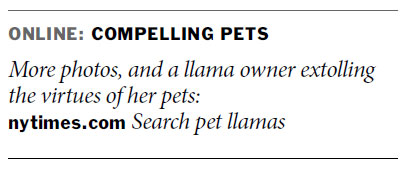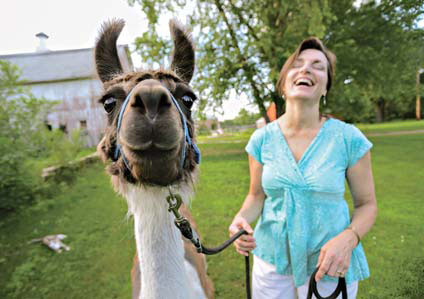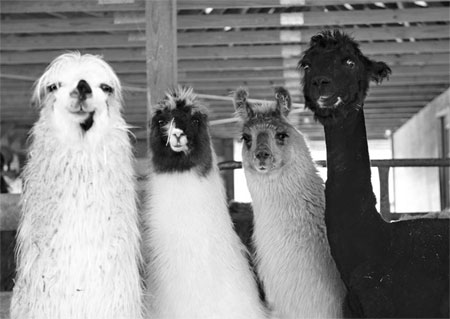The fuzzy friend in the yard: a llama
Updated: 2013-08-25 09:19
By Jennifer A. Kingson(The New York Times)
|
|||||||
|
Susan Morgan, who breeds miniature llamas in Hastings, Minnesota, says the animals bond among each other by humming. Caroline Yang for The New York Times |
|
Llamas' popularity as warm and fuzzy pets is growing. Yearlings at a farm in Ballston Spa in New York. Jennifer May for The New York Times |
People who keep llamas as pets will readily offer you any number of reasons: llamas are quiet, they're gentle and affectionate, they don't take a lot of work to maintain and they don't smell bad.
But it's more than that. Look at a llama and it'll gaze back sympathetically with those huge, beguiling eyes, ears perked up, looking for all the world like it understands you and really cares.
As Katrina Capasso discovered, "They're like potato chips." It's hard to stop at just a few. Ms. Capasso, 49, lives in Ballston Spa, about 260 kilometers north of New York City. She got her first llama as a wedding gift from her husband, Gary, in 1990. Now she has 55.
Used as pack animals in South America for centuries, llamas are now owned and bred throughout the world. A few decades ago, they were almost unheard-of in the United States. Today there are about 115,000, according to the International Lama Registry.
Llama breeders can pay as much as $30,000 for a top-quality male, but a regular pet llama can be had for less than $500. And given the demand for llama fiber among knitters, owners might be able to earn some of that back.
Pam Fink and her husband, Jerry, both 65, enjoy spending summer nights in Georgia sitting on their porch, watching the llamas graze. "I refer to them as our walking lawn ornaments," he said fondly.
Mrs. Fink now breeds miniature llamas, a distinct breed about three-quarters the size of standard llamas. In the Finks' immaculate suburban house, framed portraits of their pet llamas hang over the fireplace alongside photos of their grandchildren. Another wall is covered with ribbons won at llama shows, which are similar to dog shows.
One morning, Mrs. Fink showed a visitor around the house and then gave a tour of the barns where the llamas live, offering a running commentary on their quirks and personalities. "This is Dolly," she said. "She likes to eat in front of the window." (Llamas prefer hay, grass, minerals and grain; some owners say they cost about the same to feed as big dogs.)
Llamas are strictly outdoor animals, and males must be kept separate from females or they will mate nonstop. Otherwise, they are very restrained. Owners must check them carefully to see if they are hurt or sick, because llamas are so stoic they seldom complain. They can live for decades.
Mrs. Fink likes to take a llama for a walk in the woods. "They're just so calming and enjoyable to be around," she said.
Richard Snyder, a retired corporate executive, bought a farm in Milford, Pennsylvania, in 1985, as a country retreat. A few years later, he got three llamas. Now he has nearly 60. He not only breeds them, but also uses their manure to fertilize his vegetable gardens. "I can't envision life without llamas," he said.
Llamas are quiet, but when a male is interested in a female he makes a noise that sounds a bit like gargling. Female llamas make clicking sounds. And all llamas hum. It's part of bonding, said Susan Morgan, 54, who breeds miniature llamas in Hastings, Minnesota. "They recognize each other by the hum."
Mrs. Fink has a cat and two dogs, but her llamas offer the most comfort. "I can just feel my heart rate go down," she said.
Some llamas dispense comfort professionally. Ambassador llamas visit schools, churches and libraries; therapy llamas spend time with the sick and disabled.
"Llamas have an amazing sixth sense," said Robin H. Turell, 55, who breeds llamas in Cypress, Texas. "They are very good with people with special needs."
Dr. Jane Rudd, a physician in Duluth, Minnesota, tells of a particularly sensitive llama, named Amigo, that she took to visit schools. After Amigo spent one morning with some schoolchildren, a teacher asked if she could bring in a special-needs group. "There were probably 8 or 10 noisy, awkwardly moving little kids, and one was in a wheelchair," Dr. Rudd recalled. "He had really high special needs."
Amigo perked up and led her straight to the boy in the wheelchair. "He laid his head in this little guy's lap," she said. "He just knew, 'This is someone who needs me.'"
The New York Times

(China Daily 08/25/2013 page9)

